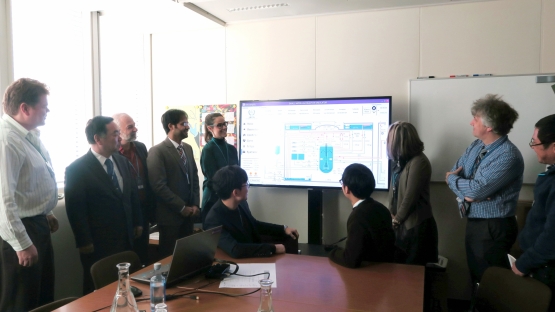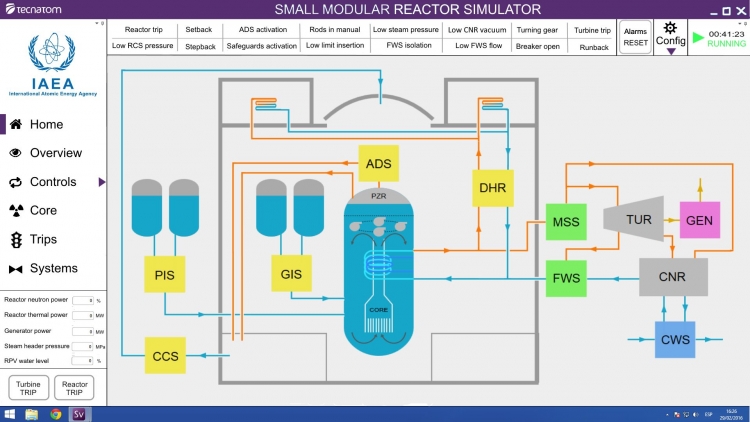IAEA Spearheading Training Programmes on Small Modular Reactors

The IAEA's consultancy meeting on "Acquiring the iPWR
Simulator through Site Acceptance Test", 5 December 2016. (Jennet
Orayeva / IAEA)
With increased global demand for alternative energy sources,
many developing countries are considering the introduction of nuclear
power programmes to meet growing energy needs. This, in turn, has
necessitated the exigency for nuclear science/technology education
programmes, helping nuclear professionals maintain and expand their
nuclear expertise.
As the global hub for exchange in peaceful nuclear technologies, the IAEA is spearheading training programmes with the development and distribution of simulation software and training courses. With the recent addition of a Small and Medium Sized or Modular Reactor (SMR) simulator, the IAEA bolstered its collection of educational nuclear power plant simulators.
The brand new simulator of an integral pressurized water reactor (iPWR) type is the first and only freely available simulator to understand the physics and technology of SMRs for educational purposes. Responding to growing interests and activities in SMR technology, the simulator is available for free to all IAEA Member States. It comes with proper manuals in order to understand the intricacies of this technology, along with ways to perform various exercises.
As the global hub for exchange in peaceful nuclear technologies, the IAEA is spearheading training programmes with the development and distribution of simulation software and training courses. With the recent addition of a Small and Medium Sized or Modular Reactor (SMR) simulator, the IAEA bolstered its collection of educational nuclear power plant simulators.
The brand new simulator of an integral pressurized water reactor (iPWR) type is the first and only freely available simulator to understand the physics and technology of SMRs for educational purposes. Responding to growing interests and activities in SMR technology, the simulator is available for free to all IAEA Member States. It comes with proper manuals in order to understand the intricacies of this technology, along with ways to perform various exercises.

Demostration exercise of the iPWR Simulator (Chirayu Batra / IAEA)
Similarly,
throughout 2016, the IAEA has conducted several activities, including
training courses and demonstrations, in Asia, North Africa, and Latin
America in order to support education and training on nuclear reactor
systems. A regional training course in Daejon, Republic of Korea, was
specifically targeted for Asian Member States. Upon request from the
Arab Atomic Energy Agency (AAEA), another regional training course in
Tunis, Tunisia, was the first such event held for Arab Member States.
Finally, in December, in Latin America, Mexico hosted one of the largest simulator training courses ever held.
Covering three major regions, the courses supported the IAEA’s
assistance to newcomer nations that are considering, planning or
actively working to include nuclear power in their energy mix.
“The course was taught in a very didactic manner, using instructors with extensive knowledge and experience on the behaviour of PWR type reactors,” said Huberto Gonzalez, who participated in the IAEA’s simulator course, jointly held with Mexico’s Instituto Nacional de Investigaciones Nucleares (ININ). “It is very useful, because in the case that Mexico wants to expand its nuclear plants, it helps to have the knowledge base to choose the best type of reactor that’s adequate to the country’s needs.”
In a conscious effort to expand the use of this training course to help countries in their national education and training programmes, the simulators were also demonstrated at the biennual Austrian “Long Night of Research” event, the IAEA’s 60th General Conference and the 3rd Nuclear Knowledge Management Conference.
With the distribution of more than 200 simulator software to 36 Member States and 75 organisations, the interest in member states to use this training methodology is increasing. The simulators can be easily operated from personal computers, do not require high end computing capabilities, have intuitive graphic user interfaces, and are particularly useful for newcomer nations and universities interested in developing or adapting nuclear engineering courses.
More information, including instructions on downloading all the simulators, is available on the IAEA web site.
“The course was taught in a very didactic manner, using instructors with extensive knowledge and experience on the behaviour of PWR type reactors,” said Huberto Gonzalez, who participated in the IAEA’s simulator course, jointly held with Mexico’s Instituto Nacional de Investigaciones Nucleares (ININ). “It is very useful, because in the case that Mexico wants to expand its nuclear plants, it helps to have the knowledge base to choose the best type of reactor that’s adequate to the country’s needs.”
In a conscious effort to expand the use of this training course to help countries in their national education and training programmes, the simulators were also demonstrated at the biennual Austrian “Long Night of Research” event, the IAEA’s 60th General Conference and the 3rd Nuclear Knowledge Management Conference.
With the distribution of more than 200 simulator software to 36 Member States and 75 organisations, the interest in member states to use this training methodology is increasing. The simulators can be easily operated from personal computers, do not require high end computing capabilities, have intuitive graphic user interfaces, and are particularly useful for newcomer nations and universities interested in developing or adapting nuclear engineering courses.
More information, including instructions on downloading all the simulators, is available on the IAEA web site.




No comments:
Post a Comment